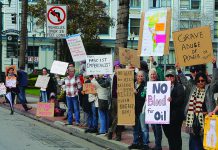
With all the controversy surrounding California’s mandated housing bill, let’s take a look back to a time when our very own Town Council considered making an even more draconian move.
During the 1960s, downtown businesses were losing customers to the popular new concept of shopping malls such as Valley Fair. Desperate merchants formed a group called “Progress, Inc.” to lobby for relief.
The Los Gatos-Saratoga Board of Realtors commissioned a study to help pave the way for change, focusing on residential neighborhoods near downtown. It concluded that “to provide continued commercial growth, the disposable income of citizens MUST increase—there is no other way under our free society.” Given that “most of the present residents are retired and live on bare subsistence incomes,” displacing them with “families who can afford many of the niceties of life” will result in “a greatly expanded market available to our local businesses.”
As a first step, the study recommended demolition of the entire square block of “older worn-out structures” bounded by Bean, Massol, Tait and Nicholson Avenues and construction of two “high-rise, high-rent apartments of pleasing design.” This would “provide better streets, add substantially to the town tax base, provide a ‘shot-in-the-arm’ to our downtown area through increased purchasing power, increase property values, provide landmarks where none now exist, and bring to our town substantial and cultivated citizens.” It would be the first of many such developments throughout town. No thought was given to historic preservation or to what might happen to the displaced families under this sweeping program.
The stage was set for a massive transformation of Los Gatos and the surrounding area to support a predicted population of 90,000 by 1985
In a speech before the Board of Realtors on Sept. 24, 1963, Town Manager Donald McIntyre agreed, adding: “The community would benefit from an increase in real estate taxes by filling downtown areas with high-rise apartments. Residents would have fewer children, so little or no impact would be made on the educational system.”
To explore further, the Town Council voted to retain the services of a land-use consultant. Portions of the consultant’s report, combined with provisions of the Federal government’s Urban Renewal program, were incorporated into a new General Plan. Under Urban Renewal, building inspectors were given unquestioned power to condemn any structure not meeting current building codes. If codes were updated annually, all buildings more than a year old would be out of compliance. Entire neighborhoods could be razed. There was no provision for appeal.
Town Hall insiders proposed designating the entire downtown area between Massol Avenue and Highway 17 as an Urban Renewal zone. The stage was set for a massive transformation of Los Gatos and the surrounding area to support a predicted population of 90,000 by 1985!
Fortunately, this misguided vision was never realized, but not before the historic 1917 First Baptist Church was bulldozed and replaced with the Penthouse apartment tower. It stands today as a stark reminder of how all of downtown Los Gatos might have looked under Urban Renewal.
After the Loma Prieta earthquake, preservation and restoration efforts led to the creation of the Downtown Historic Commercial District which was subsequently listed on the National Register of Historic Places. In 2008, the Town Council under Mayor Barbara Spector passed an ordinance creating the Almond Grove Historic District to recognize and preserve the historical, architectural, and cultural significance of this once maligned, and now-treasured, neighborhood.
For more stories about the fascinating but mostly forgotten people, places and events that have shaped our town, download the free smartphone app “Discover LOST Gatos” from the Apple App Store or Google Play and enjoy all three self-guided historical walking tours.









